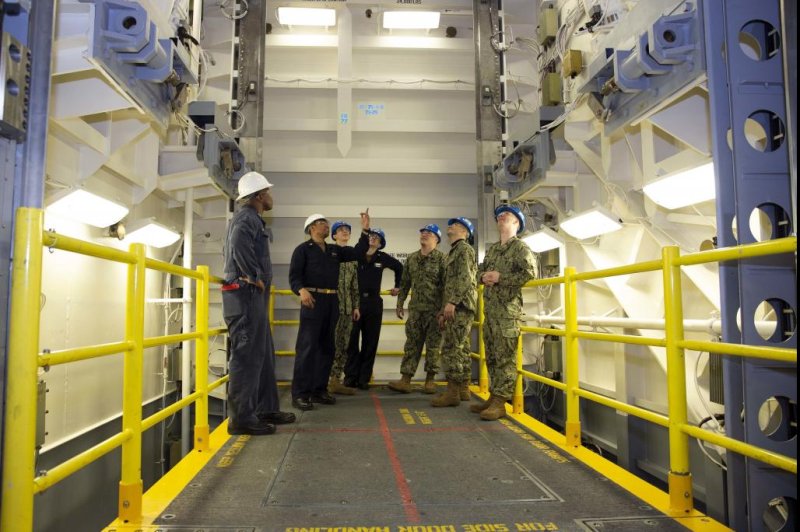1 of 2 | Chief Machinist's Mate Franklin Pollydore (second from left) goes over safety procedures for the Upper Stage 1 advanced weapons elevator with sailors from USS Gerald R. Ford's weapons department. Photo by Mass Communication Specialist 1st Class Jeff Troutman/
U.S. Navy
Jan. 17 (UPI) -- The USS Gerald R. Ford completed a major construction milestone with the acceptance of its first advanced weapons elevator, the U.S. Navy said.
On Dec. 21, the AWE Upper Stage #1 was turned over to the ship after testing and certification by engineers at Huntington Ingalls Industries' Newport News Shipbuilding in Virginia, the Navy said Wednesday in a news release.
The vessel had been delivered to the Navy without working weapons elevators, a source of controversy that led Secretary of the Navy Richard Spencer to emphasize that the elevators would be operational by the end of this summer -- and told President Donald Trump to fire him if they were not.
The new elevators are commanded via electromagnetic, linear synchronous motors, which allows for greater capacities and a faster movement of weapons than the Nimitz-class carrier elevators that utilize cables for movement.
The initial Ford-class aircraft carrier is the first new carrier design in more than 40 years.
The ship is capable for moving up to 24,000 pounds of ordnance at 150 feet per minute, compared with 10,500 pounds at up to 100 feet-per-minute on a Nimitz-class carrier.
"This will allow us to load more aircraft faster, and in the long run, increase our overall sortie generation rates," said Lt. Cmdr. Chabonnie Alexander, Ford's ordnance handling officer.
Three upper stage elevators can move ordnance between the main deck and flight deck, and seven lower stage elevators are capable of moving ordnance between the main deck and the lower levels of the ship.
They also are designed to evacuate injured personnel from the flight deck to the hangar bay.
"Getting this elevator turned over to the ship and allowing our sailors to get hands-on training on the elevator will help in two ways," Alexander said. "One, it will help in the training and understanding of the system itself, and two, to work out any bugs that remain with the system during our PSA [post-shakedown availability.]"
All shipboard installation and testing activities of the 10 elevators are due to be completed before the end of Ford's PSA, scheduled for July.
"To be able to finally push the buttons and watch it operate like it's designed to do was a great feeling," Alexander said. "Once these systems are proven, they are going to pay huge dividends for naval strike capability."
Navy Secretary Richard V. Spencer is committed to having working weapons elevators on the Ford by the end of the summer.
On the morning before the Army-Navy football game last December, Spencer told President Donald Trump that the elevators would be installed and working by the time the carrier returns to sea.
"I asked him to stick his hand out; he stuck his hand out," Spencer told USNI News. "I said, 'let's do this like corporate America.' I shook his hand and said, 'the elevators will be ready to go when she pulls out or you can fire me, '" Spencer said.
"We're going to get it done. I know I'm going to get it done. I haven't been fired yet by anyone; being fired by the president really isn't on the top of my list."















